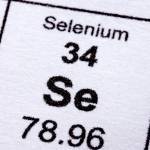Determining Selenium Stores in Horses

Selenium is an important micronutrient for all animals, playing a crucial role in the synthesis and use of a potent antioxidant called glutathione peroxidase (GPx). While selenium can be measured in the bloodstream, those levels don’t necessarily reflect selenium levels in other body compartments.
“A 500-kg exercising horse needs 1-1.25 mg selenium per day according to Nutrient Requirements of Horses, published by the National Research Council. Kentucky Equine Research suggests a higher intake of selenium for exercising horses at 2-3 mg per day, as part of our recommended daily allowances to support overall health and performance,” explained Catherine Whitehouse, M.S., a Kentucky Equine Research nutrition advisor.
Because much of the world’s soil is marginal or deficient in selenium, many horses require dietary supplementation for optimal health.
“However, some areas have excessive soil selenium, such as Wyoming and South Dakota in the United States, several counties in Ireland, Central Queensland in Australia, and some areas around Auckland, New Zealand. This may pose a risk for excessive selenium intake when horses consume forage grown in these areas. In these cases, supplementation should be avoided,” warned Whitehouse.
Horses rarely show clinical signs of disease associated with selenium deficiency. When it does occur, clinical syndromes of deficiency include white muscle disease and steatitis in foals as well as nutritional myopathies in adult horses. Steatitis, also called yellow fat disease, is a rare condition that involves painful inflammation of fat, often in the neck. Steatitis is characterized by inappetence, depression, and fever.
Selenium levels increase rapidly after consuming selenium-containing feeds, followed by a rise in GPx. Based on previous research, GPx is believed to better reflect an animal’s selenium nutritional status, offering an improved method of determining selenium deficiency. Further, GPx reflects the long-term selenium availability rather than an immediate measure (such as measuring blood selenium levels).
To determine the relationship between blood selenium levels and GPx levels in both blood and muscle samples, researchers collected samples from horses residing in Chile, a country known for selenium-deficient soils.
Despite this known deficiency, circulating (blood) levels of selenium were within accepted reference ranges in 78% of horses and above the range in the remaining horses. None of the horses had received any selenium supplementation before the study. A strong positive significant relationship between selenium and GPx in blood was observed, meaning that as selenium levels in blood increased, so did the GPx levels. However, no correlation between blood and muscle GPx enzymatic activity was identified.
“The authors suggested that GPx levels should be used to assess cases of subclinical disease, as it may identify cases of chronic selenium deficiency, despite blood selenium levels appearing to be normal,” explained Whitehouse.
When comparing GPx values in the study horses to an established reference range, 43.5% of the horses were below the reference ranges, suggesting subclinical selenium deficiency.
“This subclinical deficiency is more in line with what would be expected in unsupplemented horses managed in a low-selenium area,” Whitehouse noted.
Together, these findings confirm that blood GPx is a reliable biomarker for circulating levels of selenium in horses but does not correlate to muscle GPx levels.
A simple but effective way to assess nutrient adequacy in the horse’s diet is to conduct a detailed ration evaluation that compares nutrient intakes to nutrient needs. The nutrient composition of the forage, feed, and supplements is multiplied by the intake level to calculate nutrient intake totals.
According to Whitehouse, “Veterinarians and nutritionists can work together to assess the nutritional needs and health of the horse using a variety of tools, which may include blood testing in some cases. This study, however, highlighted the limitations of blood analysis in indicating cases of chronic deficiency.”
Selenium supplementation is required in low-selenium areas for optimal health and performance. Look for a fortified feed in your area to provide your horses with complete and balanced nutrition.
*Deride, C., R. Chihuailaf, V. Arnés, G. Morán, and B. Uberti. 2023. Relationship between selenium, copper, zinc and their biomarkers in blood and skeletal muscle tissue in adult horses from Southern Chile. Journal of Equine Veterinary Science 128:104881.








